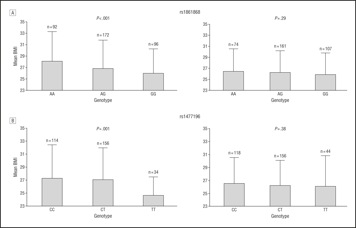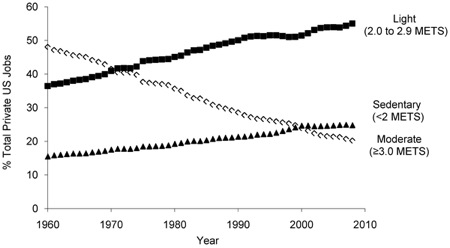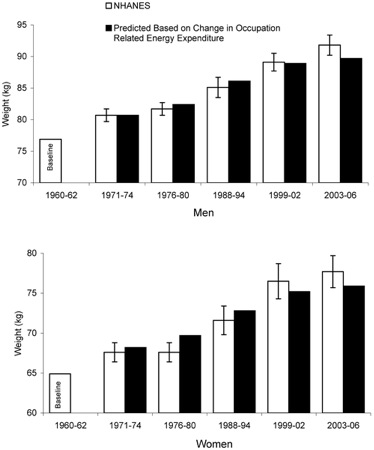Inactivity and Obesity
This post is on how inactivity is a major player in the obesity epidemic. It is data rich so fasten your seat belts. That having been said, I want to make three main points:
- Physical inactivity is an extremely recent experience for humans as a species.
- People with high levels of physical activity are protected from obesity.
- A loss of physical activity at work as we all become desk jockeys is a big reason why we are getting fatter as a population.
Inactivity is recent.
Dates vary but modern humans emerged out of Africa and began to spread to the rest of the world about 40,000 years ago. For the next 30,000 years essentially we were all hunter gatherers. Based on a variety of estimates, including observations in the few remaining hunter gatherer societies, it appears that many adults hunter gatherers walk between 10 and 20km (6-12 miles) per day. There also appears to be essentially no obesity in these societies. There are complex potential interactions between their activity levels and what they were eating, but many groups of hunter gatherers had access to plenty of food. Granted the variety might have been minimal, but for many there were plenty of calories.
About 10,000 years ago agriculture emerged during something called the Neolithic Revolution. We have at least some idea about the activity levels associated with muscle power (human or draft animal) farming from the Old Order Amish who practice agriculture without the benefit of electricity or tractors but do use horses! It is also pretty clear that they eat an awfully lot of what could be called traditional high calorie farm food. Here is a quote from adapted a classic study on the Old Order Amish.
“The average number of steps per day was 18,425 for men versus 14,196 for women. Men reported 10.0 hours per week of vigorous physical activity, 42.8 hours per week of moderate physical activity, and 12.0 hours per week of walking. Women reported 3.4 hours per week of vigorous physical activity, 39.2 hours per week of moderate physical activity, and 5.7 hours per week of walking. Men had higher levels of energy expenditure than women. A total of 25% of the men and 27% of the women were overweight (BMI > or = 25), and 0% of the men and 9% of the women were obese (BMI > or = 30).”
High levels of physical activity protect against obesity.
The data above mean that most Old Order Amish are essentially physically active all day long most days. Contrast their BMI values with the values for the U.S. population as a whole that I reviewed earlier this week, 35% obese and 60-70% overweight. Another interesting thing about the Old Order Amish is that their high levels of activity protect them from two gene variants that seem to predispose sedentary people to higher BMIs. The left panels on the figure below show that for Old Order Amish in the bottom 50% of physical activity there is a relationship between the gene variants and BMI. The right panels show that for those in the top 50% of physical activity there is no relationship between the gene variants and BMI. Genetic predispositions get blamed for all sorts of things but the environment, culture and lifestyle typically has an even bigger role for most common conditions. Again high levels of physical activity are protective against obesity.
Physical activity at work matters.
The Old Order Amish are people who are clearly active all day long with farming and household chores. They are probably as active or even more active than hunter gatherers were. However, in the last hundred years a muscle powered way of life has vanished for most of us. So, what about the rest of us? It turns out that over the last 50-100 years most of us are doing less and les physical activity at work. The slide below is from a terrific scientific paper on this topic. It shows that as over the last 50 years the number of people employed in jobs associated with moderate physical activity has declined from about 50% to 20%. As the authors note:
“From 1960 to 2008 there was an approximate drop in occupation-related daily energy expenditure of 140 calories for men and 124 calories for women.”
For most of us that is like walking (or not walking) 1 to 1.5 miles during the day. What is even more amazing is how these missing calories add up and explain population based weight gain over the last 40 or 50 years. The figure below also from this paper shows the impact of the missing calories on estimated changes in body weight over time and how the match up with the NHANES population surveys in the U.S. It is incredible how well the numbers match up. It is also incredible what a big impact just over 100 hundred calories a day has.
Summary
Hunter gatherers and traditional farmers were very active and almost none were fat even when there was plenty of food around. However, you don’t have to be that active to avoid the being a statistic in the current obesity epidemic. The data on occupational energy expenditure from the last 50 years shows that burning an extra 100-150 calories a day can have a huge impact on population based body weight statistics. From a practical perspective what would happen if everyone went for a brisk 20-30 minute walk at lunch every day?
This entry was posted on Thursday, August 23rd, 2012 at 6:28 am and is filed under Current Events, Physiology, Research and Health. You can follow any responses to this entry through the RSS 2.0 feed. You can leave a response, or trackback from your own site.





August 23rd, 2012 at 12:11 pm
From a practical perspective, initially one might think it would decrease productivity since workers would leave their workstation for up to a half hour. However, I am sure there are studies out there showing an increase in attentiveness after a brief bout of exercise.
September 3rd, 2012 at 6:11 am
What About Diet? | Human Limits: Michael J. Joyner, M.D. says:[…] only about 5% of people are meeting the guidelines for physical activity and there has been an average loss of about 100-150 calories a day of physical activity at work for many […]